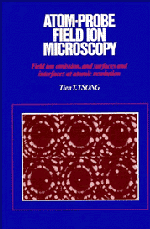
-
Select format
-
- Publisher:
- Cambridge University Press
- Publication date:
- 30 October 2009
- 30 August 1990
- ISBN:
- 9780511599842
- 9780521019934
- Dimensions:
- Weight & Pages:
- Dimensions:
- (228 x 152 mm)
- Weight & Pages:
- 0.558kg, 400 Pages
You may already have access via personal or institutional login
Book description
Atom-probe field ion microscopy is currently the only technique capable of imaging solid surfaces with atomic resolution, and at the same time of chemically analysing surface atoms selected by the observer from the field ion image. Field ion microscopy has been successfully used to study most metals and many alloys, and recently good field ion images of some semiconductors and even ceramic materials such as high temperature superconductors have been obtained. Although other microscopies are capable of achieving the same resolution, there are some experiments unique to field ion microscopy - for example the study of the behaviour of single atoms and clusters on a solid surface. The elegant development of the field ion microscope with the atom probe has provided a powerful and useful technique for highly sensitive chemical analysis. This book presents the basic principles of atom-probe field ion microscopy and illustrates the various capabilities of the technique in the study of solid surfaces and interfaces at atomic resolution. A useful comparison is given with two related techniques, electron microscopy and scanning tunnelling microscopy. The book will be of interest to scientists working on surfaces and interfaces of materials at the atomic level and will provide a useful reference for those using this technique.
Contents
Metrics
Altmetric attention score
Full text views
Full text views help Loading metrics...
Loading metrics...
* Views captured on Cambridge Core between #date#. This data will be updated every 24 hours.
Usage data cannot currently be displayed.
Accessibility standard: Unknown
Why this information is here
This section outlines the accessibility features of this content - including support for screen readers, full keyboard navigation and high-contrast display options. This may not be relevant for you.
Accessibility Information
Accessibility compliance for the PDF of this book is currently unknown and may be updated in the future.


